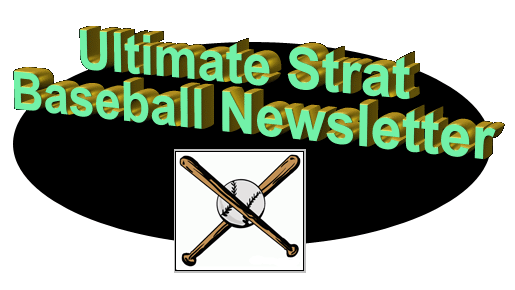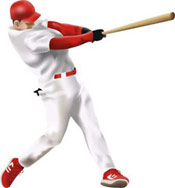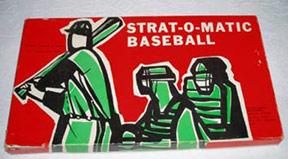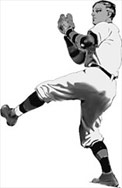Vol. II,
Issue #7 - November 2016
**
"Usage 4.2" by
Doug Brunet
**
(Lets welcome back our contributing member Doug Brunet with his
second
article to discuss
a way to prevent over-usage of players in your current draft
leagues - welcome back Doug! )
(Comments from the Wolfman:
I have known
Doug now for over 6 years in Strat and I respect him greatly not
only as a very good friend but also
as an accomplished fellow manager who is very knowledgeable about the game of
baseball and how to build a team in Strat. Doug is the
owner of the Montreal Crows in his league and although he hasn't won a championship yet he has been a leading team in his
conference making it to the conference finals several times now,
so its just a matter of time till he brings home the league
trophy.
But also my good buddy Doug
holds some key roles in the league he participates in, his
titles go from being on the Executive Council, to President of
his conference, to Roster & Player Movement Coordinator. One thing
Doug does is to make these amazing spreadsheets for his league that show
all the rosters, which players are available for their draft which also includes the full stats of how each player
performed in 2016. Anyway, Doug
is one of those members of the strat world you want to know and
pick his brain. So let's welcome him back with open arms as he shares
with all of us another great article!)
 Usage
4.2
Usage
4.2
Most, if not all, of our
summer leagues have completed the season and have crowned a
champion. To all the champions, a hearty congratulations on a
job well done. Whether you play in one league or several, or
have won your first championship or one of several, youíve
reached a summit that all of us Strat players aspire to. As much
as we have fun playing our favorite game, is as competitive as
our leagues can be. After all, that is a big part of the fun,
right?
As with any competition, a set of rules needs to
be established to maintain a sense of fair play and equal
opportunity to succeed. In many leagues, the constitutional
section concerning usage is at the heart of how a league
functions during the course of any given season. It can also
affect, to no small degree, the off season. Usage rules tend to
have strict limitations with relative associated penalties for
transgressions against these limitations. The competition itself
drives us to the limits within our respective leagueís usage
rules. Inevitably, it seems, a particular word rears up in
messages, synopses, reports, or what have youÖ..OVERUSE.
Particularly, the overuse of non-pitchers. Usage for pitchers is
much more straight forward and easier to follow.
I havenít played a season yet where overuse has
not occurred, and itís what has given me the thought to compose
this article. It isnít so much that overuse occurs. Of course,
any of us may lose track of things for one reason or another. I
mean, there are times when I get up from my chair in the living
room to go to the kitchen, and for a moment have no concept as
to why Iím there. Maybe I was doing the grocery list and went to
see if we had any eggs left, but thought of making toast with
peanut butter and away go the eggs. Until, of course, I get back
to the living room with my toast and see the unfinished grocery
list. ĎOh, yeah, eggs.í You get the idea.
No, itís not about overuse exactly, itís that
Iíve come to realize that it generally happens to the same
individuals from year to year. This is not meant as a harsh
criticism, but rather just a statement of fact. It must be
understood that there are many reasons for this. We all lead
different lives which involve a variety of circumstances that
mitigate the time we have to devote to recreation. Add to that
the varying aptitudes for wrapping oneís head around figures and
statistics. My intent here is to provide a kind of tool to help
some of our fellowship steer away from penalties which cost
draft picks, or cause the loss of players to the free agent
pool, or whatever penalty system your league imposes for the
overuse of players.
From the perspective of a general manager, itís
completely advantageous to have other teams incur penalties.
But, from the point of view of a league administrator, itís
quite undesirable. No league commissioner with integrity enjoys
imposing penalties. And no GM willingly grants unnecessary
advantages to his or her competition. And so, if what follows is of any
help to anyone, Iíll be satisfied for my part.
Although there may be variables depending on how
many teams are in a league, or to what percentage of usage a
league permits within the rules, my conclusions are derived from
a 24 team league with 100% of plate appearances (AB+BB) as itís
usage limit with a small hitch at seasonís end that has no
bearing in this study. Even if your league allows 105%, 110%,
etcÖ the figures hold up upon pro-rating your league rules.
The usage statistics generated by the game
already provides us with a wealth of information. The ĎUsage
Displayí page in the ĎTeam Statsí menu gives us a percentage of
usage and how much remains as a season progresses. For the most
part, these figures give us a firm measure of where our team
stands at any time. And yet, there must be some inconspicuous
factor that leads to overused players other than blatant
disregard for rules. We may have a need to translate remaining
plate appearances in a way that further provides us with where
we stand in relation to what it will take to get through the
season within the limits. We need to know whether or not to make
a roster move to increase available usage and at what point it
may be necessary.
For this purpose, letís invent a couple of new
reference notations. Weíre going to call them
ĎP#í
and 'G#'.
From this point on in this article, P# will represent a number
to which Iíve come to place much importance and has kept me out
of trouble over the years,
PAPGPP
(plate appearances per game per
position). G# will represent the number of grouped
positions in any given calculation. It will all make sense in
the end.
The
general P# to use as an overall guideline is
4.2. To explain
what 4.2 means, we need to throw some numbers on the table, and
from there we can analyze the pluses and minuses in relation to
4.2. The league that I am going to refer to statistically, as do
most leagues we play in, replicates actual MLB statistics in an
overall sense with uncanny accuracy.
Use this formula to
determine the P# from past results: P#=PA/(GP*G#).
To illustrate, letís
give values to the variables in the formula to determine the
P# for average plate appearances per team for a completed
season: 6082/(162*9)=4.17.
To apply a P# to project
plate appearances needed for a season: PA=GP*G#*P#.
Before
the beginning of a season, if you use 4.2 as the P# you
could project the potential need of 6,124 PA for the season
with the exception of your pitchers, who donít normally
count against usage. On average, pitchers amount to about a
half player for plate appearances. So, teams playing without
a DH in the lineup can use 8.5 instead of 9 as the G#.
But, just seeing that 4.2 is already higher than the league
average, the projection of 6,124 is estimating on the side of caution and
can be the first
step onto the path of
getting through the season without penalty for overuse.
Now, there are a number of instances that cause
variations in the average P# for a team during the long 162 game
schedule. Most are uncontrollable and inconsequential after the
fact when calculating your remaining usage after the season
starts.
Whether less or more than average, an unusual
amount of extra innings, sacrifices, hit batsmen, double plays,
and wins at home, can add or subtract to your teamís overall
plate appearances. These are already safeguarded by a P# of 4.2.
There are two numbers, however, that have a direct effect on the
P# that you may employ for calculating where you are on usage.
Most obviously, a team that scores a lot of runs
will turn the lineup over more often than a team that has
trouble scoring. Consequently, the P# should be adjusted to
anticipate that this will likely be a repeated pattern. If you
get to the quarter mark in the season scoring more than your
share of runs, youíll probably continue to do so. But, you donít
have to be scoring a lot to be wary of your usage.
The other big factor is how many runners your
team leaves on base. Team
LOB
{left on base} is even more culpable against
usage than runs scored.
-
Avg. Runs per team(162 games): 706
-
Avg. LOB: 1120
-
Avg. R+LOB: 1826 (11.27 per game)
-
Most Runs: 880
-
Most LOB: 1204
-
Most R+LOB: 2031 (880+1151 : 12.54 per
game)
-
Least Runs: 535
-
Least LOB: 952
-
Least R+LOB: 1580 (628+952 : 9.75 per
game)
Looking at the above numbers, you see a vast
difference between the most and the least. However, the
adjustment to the P# remains very close to 4.2 because youíre
breaking down your remaining usage to whatís needed per position
per game. The team that averaged 12.54 runs plus left on base
(R + LOB)
had a P# of 4.29, whereas the team that averaged 9.75 had a P#
of 4.04. The difference is that subtle for means of calculation.
Scoring runs and leaving runners on is an
indication of your teamís ability to reach base, which is what
drives your plate appearances up or down in relation. If you see
your teamís average approaching 12 or even 11.75, adjust your P#
to 4.3. Conversely, if you find yourself at 10.5 or less, you
may adjust to 4.1.
Okay, so, weíve got the meaning of 4.2, but now
we need to apply it to our usage during the season. How your
roster is constructed will give you player groupings. Normally,
leagues have rules that make backups necessary at all positions,
just as in reality. No MLB team carries one catcher, no matter
what his relative durability may be. This is fact, and we have
rules to make our Strat experience as close to reality as
possible. Usage limitations require us to fill our rosters
accordingly.
You can add up all the remaining PA for all your
outfielders and use that figure with the P# to determine how
many man-games remain for 3 positions, and then weigh that
against actual games remaining in the season. For example, say
youíve played 70 games and you have 6 players on your roster to
cover your outfield. Add the remaining PA from your Usage
Display for those 6 players and divide that by the product of
the G# and P#. Letís say the 6 playersí remaining PAís add up to
1,150, youíre using 4.2 as your P#, and your G# is 3 for the
positions in the outfield.
GR=PA/(P#*G#), or 1,150/(4.2*3)=91.3, which is
just shy of the 92 games you have left to play. If youíve been
scoring a lot of runs and leaving men on, a P# of 4.3 will drop
your available usage to 89 games worth. Itís an indication that
a move of some sort may become necessary.
Some players, like Sean Rodriguez, who play
almost everywhere may permit a grouping of 6 or 7 positions when
calculating whatís left. That part is up to the individual
manager as to how he or she uses the roster, but you get the
idea. Grouping players to determine man games remaining is key
to grasping where your team stands.
Going even further, where a player hits in the
lineup has a drastic effect, which prompts us to examine the P#
for the individual player when necessary. The chart below maps
out the vast difference from the top of the lineup to the bottom
after a completed full schedule.
|
Lineup |
Avg. PA |
P# |
High |
P# |
Low |
P# |
| Leadoff |
747 |
4.6 |
770 |
4.8 |
719 |
4.4 |
| 2nd |
725 |
4.5 |
753 |
4.6 |
703 |
4.3 |
| 3rd |
711 |
4.4 |
734 |
4.5 |
689 |
4.3 |
| 4th |
697 |
4.3 |
719 |
4.4 |
675 |
4.2 |
| 5th |
680 |
4.2 |
701 |
4.3 |
661 |
4.1 |
| 6th |
664 |
4.1 |
684 |
4.2 |
633 |
3.9 |
| 7th |
644 |
4.0 |
670 |
4.1 |
623 |
3.8 |
| 8th |
623 |
3.8 |
655 |
4.0 |
586 |
3.6 |
| 9th |
590 |
3.6 |
622 |
3.8 |
551 |
3.4 |
As we all create our lineups to maximize run
production, where a player hits in the lineup tends to stay
relatively constant. This could be where one may run into usage
difficulty the later the season goes. Obviously, if all your
outfielders bat at the top of the lineup, an adjustment to your
P# to calculate remaining usage must be made. And the reverse is
true for the bottom of the lineup.
As you can see from the above chart, the leadoff
hitter gets to the plate an additional time per game than the 9th
place hitter. Thatís 162 times more for a season, which is very
significant when planning out your season. For instance, if we
are projecting a player like Jose Peraza, the P# can be used to
see how many games he could start depending on where heís placed
in the lineup. The G# is not needed for an individual player.
In 72 games for the Reds, Peraza hit .324 with
an OBP of .356 and stole 21 bases. Not a bad leadoff hitter,
right? Except his 248 PA will limit his playing time. On
average, he could be projected to start 54 games leading off.
But, if he is placed 9th in the lineup, the
projection is 69 games. (GR = games remaining)
GR=PA/P# : 248/4.6=53.9 leading off or 248/3.6=68.9 batting 9th.
Also notable in the chart above, is that the
average P# in the dead center of the lineup is 4.2. Thatís a
full season for 24 teams. Itís not a coincidence. Keep your team
out of usage trouble and stay clear from penalties with these simple
formulas. You
can apply them to your team as a whole, to a grouping of players,
or to an individual player.
Find it: P#=PA/(GP*G#)
Apply it: GR=PA/(P#*G#)
Doug Brunet
(NOTES from the Wolfman:
We want to thank Doug for offering this new perspective on how
to manage your players on your draft team using the "4.2"
average/ Plate Appearances / game to determine each player's
uage on your team. If some
part of this article caught your fancy and you want to give Doug
a shout out, you can certainly reach him via his email at:
Contained inside this exciting issue of Ultimate Strat
Baseball Newsletter:
(to view the various interviews, articles, columns and special sections click on
the links {underlined}
and this will take you to the appropriate
webpage)
♦
RETURN TO NEWSLETTER MAIN PAGE
♦
STRAT THOUGHTS with
BRUCE BUNDY,
after a long absence we have the mind of Bruce Bundy as he
shares with our members over 30 formulas used to build the
cards, that he is known for throughout SOM Baseball and a
special comment about Baseball Daily.
♦
SOM BASEBALL LEAGUE REPORT with WOLFMAN SHAPIRO
--
the editor of "The Ultimate Strat Newsletter" and 2012 CBA
Champion, talks to members of various Strat-o-matic Baseball
Leagues that he has discovered on the internet about the
history of their league and their experiences. We speak
to another commissioner of a Retro League. To read this interview, click on the link below:
INTERVIEW with JIM
MURPHY, Commissioner of OSBL, P-XII
(Computer/Netplay)
♦
ARTICLE with WOLFMAN
SHAPIRO (linked with Baseball Daily),
This the Wolfman's fourth and final report about the new "Baseball Daily" game play
with SOM Baseball as he finished managing the 2016 Chicago Cubs
day by day. He shows you his results through the end of the
season and give an analysis linked to the Cubs how they really
played throughout the year on the road to their World Series
Championship, the first in 108 years, the end of the curse.
♦
STRAT WISE with MARC WASSERMAN
commissioner of the Cyber Baseball Association (CBA) continues
his new column sharing various perspectives on SOM Baseball.
For his
article this month we include a summary of the
latest and most fascinating and interesting videos we have added
to our Ultimate Strat Baseball Youtube Channel including two
special videos for the holidays shared in mid-December
including one by the Wolfman and Marc himself talking about
the new "Infield Shift Rule".
♦
ARTICLE with GLENN
WHEELER,
Glenn is the commissioner of NASOMA, and has been a very
supportive member of our newsletter, who we have spoken to
before about his league. He returns this month with a special
article about "Why Do We Play this Game (Strat Baseball)".
Probably many of you will totally resonate with what Glenn has
to say!
♦
RECOMMEND
ON-LINE SOM RESOURCES
--
On-line Strat-o-matic and Baseball related websites
that offer amazing information, special tools and products to improve
your game play
that we strongly recommend. In most cases, we have had personal contact with
these sources who agree with the principle to work together and help promote each other.
♦
BOOKS TO
DIE FOR and Become a BASEBALL GURU
-- This page
is
specifically about special books we are finding that either will
expand your insights about the game of Baseball, help you in the
creation of your current league teams or with your replays and
learn more about the Strat-o-matic
Baseball Game and Game Company's
history. We
have a special arrangement with Acta Sports, who is a publisher
of a number of great baseball books (including Bill James
Handbooks) to offer for our members
a 10% discount. We will continue to add more books to this page in the future
as we uncover other gems our members should know about.
Contact Us for Questions or Submissions:
Wolfman Shapiro
Founder/Editor, the
Ultimate Strat Baseball Newsletter
email:
wolfman@ultimatestratbaseball.com
facebook:
www.facebook.com/wolfman.shapiro
twitter:
@StratBaseball4U



